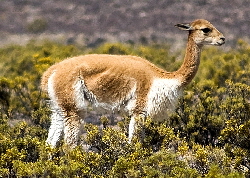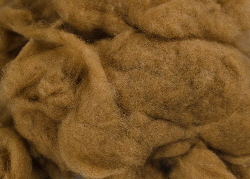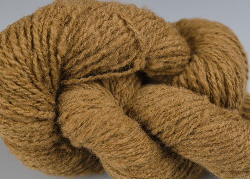|
Vicunas are wild relatives of alpacas and produce one of the finest fibres in the world. Their cinnamon colour fur is incredibly lightweight and very warm. Vicunas are thought to be the wild ancestors of domesticated alpacas.
1) Biology of vicunas
2) Vicuna history
3) Vicuna fibre
4) Spinning vicuna fibre
 Biology of vicunas Biology of vicunas
Vicunas are shy camelids that live wild in high areas of the South American Andes. Their coat is cinnamon brown on the back, whilst the hair on the throat and chest is white and quite long. They are small, weighing around 50 kg, and are more delicate and graceful than alpacas or guanacos. Vicunas are almost impossible to domesticate as they have great skill in escaping. They are the national animal of Peru, which is the country with the largest number of vicunas.
Vicuna history
The Incas greatly valued vicuna fur and referred to it as ‘fibre of the Gods’. They protected the animals under their laws and only Inca royalty were allowed to wear garments made of vicuna fur. Instead of trying to keep these animals in captivity, every four years the Incas rounded up herds of wild vicunas in a communal activity called chaku or chaccu. They surrounded the herd by forming a human chain holding a long rope decorated with flags and ribbons and funnelled the animals into a holding pen. The vicunas were then sheared and released. There were an estimated 2 million vicunas in the 16th century.
The Spanish invaders had a very different approach. Rather than go through the effort of gathering the wild animals, they found it easier to just shoot vicunas and take their fur. From that time until 1964, hunting was unrestricted and as a result the population crashed to only 6,000 animals. Vicunas were declared endangered and once again protected by law as in Inca times. Trade in vicuna fur was forbidden and slowly the population recovered to 350,000 animals across South America.

In 1993, their status was changed from Endangered to the lesser category of Threatened and controlled trade is now allowed. Vicuna is on Appendix II of the CITES list (Convention on International Trade in Endangered Species). An active conservation programme is still needed to protect the vicuna population from poaching and from habitat loss. They are classified as Least Concern on the IUCN (International Union for Conservation of Nature) Red List.
The chaccu, which had not been performed within living memory, was reintroduced under controlled conditions. Some communities now use motor bikes rather than a human chain to speed up the process. Chaccu provides opportunities for eco-tourism; it ensures that animals are treated fairly, and it ensures that local communities get a share of the income from the sale of vicuna fibre.
The vicunas are rounded up every year and all vicunas with fur longer than 2.5 cm are shorn, which helps prevent poaching. Vicuna fibre grows very slowly and each animal is sheared every two years producing between 120 and 150 g of fibre per animal; they are sheared at most 5 times in a lifetime.
Vicuna fibre
Vicuna produces small amounts of very fine hollow fibres. With a diameter of 12 micron, this is the finest legal wool in the world. By comparison the very best cashmere measures 13 micron, while average cashmere is between 14.5 and 17.5 micron. Vicuna fibre is very soft and warm, an adaptation to the freezing temperatures of the Andes. This cinnamon coloured fibre is almost always sold in its natural colour.
 Vicuna fibre is very valuable and it is sold on the world market for large amounts of money. Finished items such as sweaters and scarves sell for thousands of pounds. A pure vicuna scarf can cost just under £3,000 (US$4,500) while a man’s coat can be as much as £22,000 (US$33,000). Vicuna fibre is very valuable and it is sold on the world market for large amounts of money. Finished items such as sweaters and scarves sell for thousands of pounds. A pure vicuna scarf can cost just under £3,000 (US$4,500) while a man’s coat can be as much as £22,000 (US$33,000).
Spinning vicuna fibre
To spin vicuna fiber you need a small supported spindle such as a cotton spinning takli. You can spin directly from the fibre or you can make rolags with fine carders. 10 g of fibre goes a long way and I managed to spin nearly 50 metres of plied yarn. The yarn can look chocolate brown rather than cinnamon after it is spun. Vicuna is often blended with the more affordable cashmere to make it go further.
Top of page
|

